It’s always exciting to escape Windhoek and the office, and even more so when we have the opportunity to visit a gorgeous new super-luxury lodge, Onguma Camp Kala, located on the western border of Etosha National Park. We’d decided to break the long journey north with a night at the charming Ohange Lodge in the Otavi Mountains. On arrival at the entrance gate, we received an enthusiastic welcome from the security guard who directed us along the (definitely 4×4 only!) winding track to the lodge.
The Otavi Mountains are made up of sedimentary dolomite rock, riddled with cave systems and supporting lush vegetation. This area receives above average rainfall compared to the rest of Namibia, which makes it ideal for agriculture as well as being a beautiful place to visit after the stark, southern desert. Ohange Lodge is nestled within mature woodland filled with gnarled Leadwood trees, Marulas, Wild Fig, acacia, combretum, and many species of aloe growing along the pathways. Driving through the riverbed before reaching the lodge felt as though we were entering an ancient, enchanted forest. The faeries were hiding from us, but we were lucky enough to see a male paradise flycatcher flitting through the trees in front of the restaurant, hunting insects as the daylight started to fade.
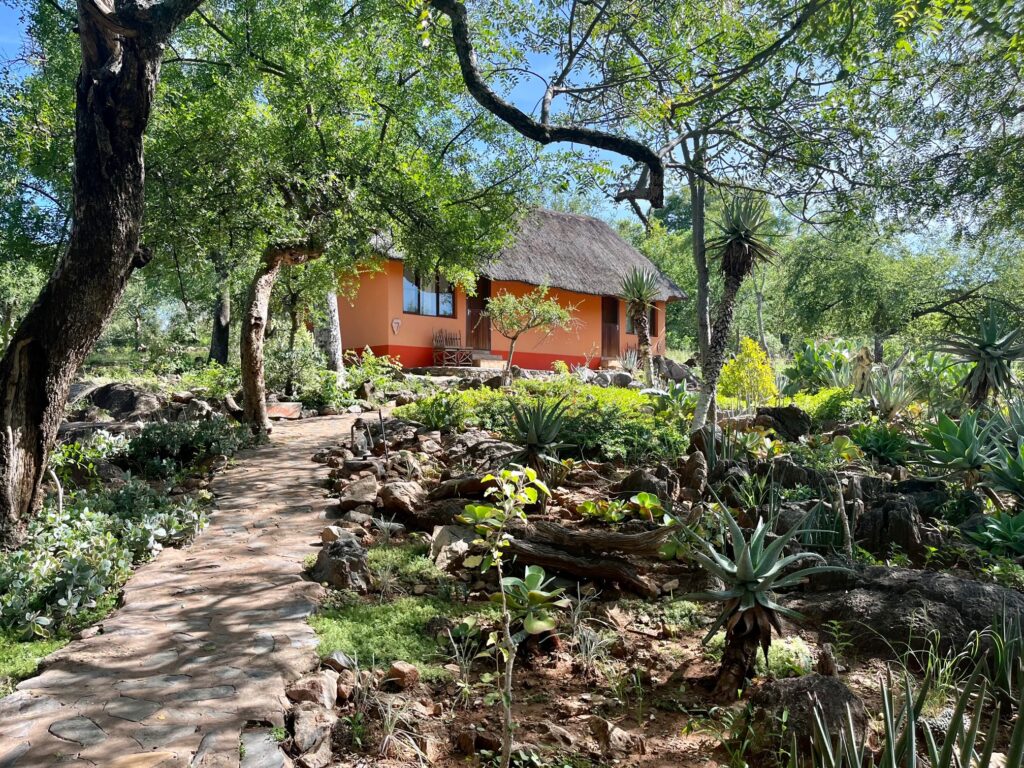
After enjoying a refreshing welcome drink, we were asked whether we would like to join a family table for dinner or eat alone. My initial panic was heightened by the fact that the only other guests staying that night had also just checked in and were standing expectantly in front of us. Also, they were German, and my foreign language skills begin and end with “I am 11 years old, and I have one sister”. Of course, it was highly unlikely that we would ever see these people again, so there was little danger of causing offence, or so I thought. Eventually I managed to stammer that we would probably prefer to sit alone, to which the other guests responded by ‘jokingly’ telling me that “We don’t bite you know!”. That evening we enjoyed a peaceful, romantic dinner overlooking the waterhole, and the following morning we came down to the dining area to discover an intimate breakfast table set for all five guests… Our compatriots replied to my hearty “Good Morning!” with a barely perceptible lifting of the eyebrows.
Unfortunately we didn’t have long enough to enjoy any of the guided activities on offer at Ohange which include afternoon nature drives, after-dinner night drives in search of owls, porcupines, bushbabies, and perhaps the occasional elusive leopard, and guided bush walks. The birdlife in this area is phenomenal and while just sitting relaxing after breakfast watching the trees in front of the main lodge we saw glossy starlings, the male paradise flycatcher again, hornbills, and a long-suffering male weaver being berated by his partner for not creating their new nest quite to her liking.
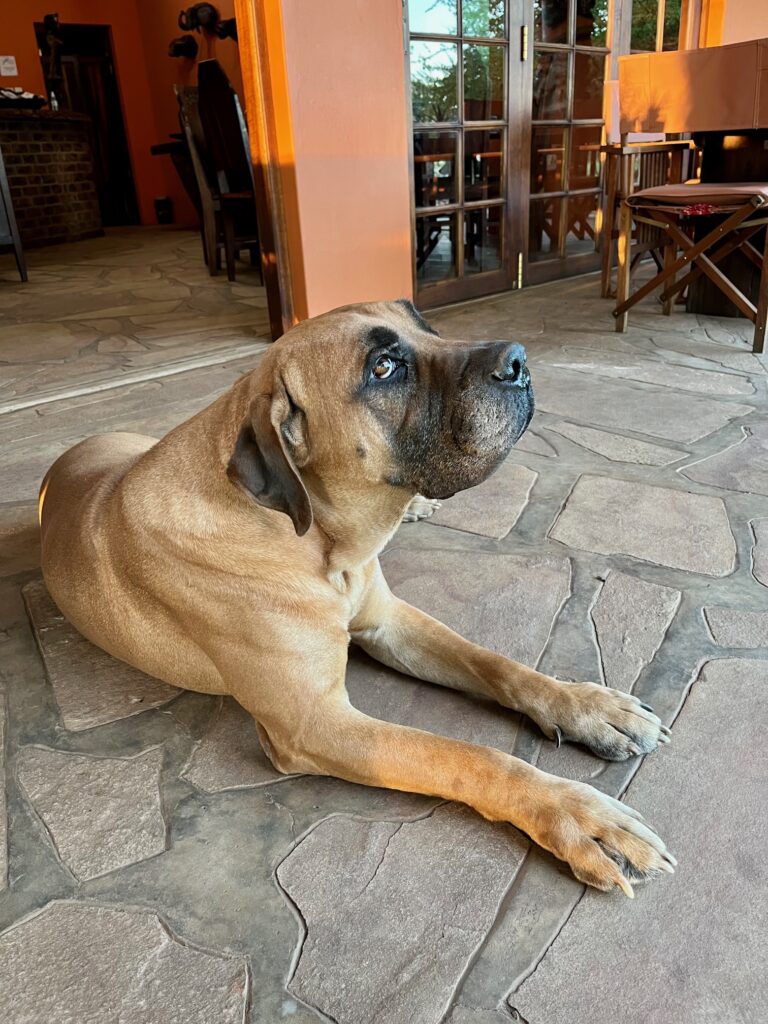
From Ohange we drove further north to the eastern border of Etosha National Park, and Onguma Game Reserve, excited to visit the new Onguma Camp Kala which opened in November 2022. Kala was built on the footprint of the old Onguma Tree Top Camp but is unrecognisable from the original lodge. Consisting of just four huge luxury suites, all overlooking an expansive waterhole, Kala is a flagship property taking Namibia’s luxury safari offering to a new level. Each suite has a massive deck with a shaded outdoor sala (day bed), wood fired hot-tub, sun loungers, and a plunge pool ideal for cooling off after a dusty morning game drive.
Guests are taken care of by a personal host who attends to their every need; as a Mum this felt like a very exciting role reversal, although I hope I wasn’t quite as demanding as our children sometimes are. Our host helped us organise when our hot tub was lit and prepared, order snacks and specific drinks to our suite, book Spa appointments, and choose our mealtimes and preferences.
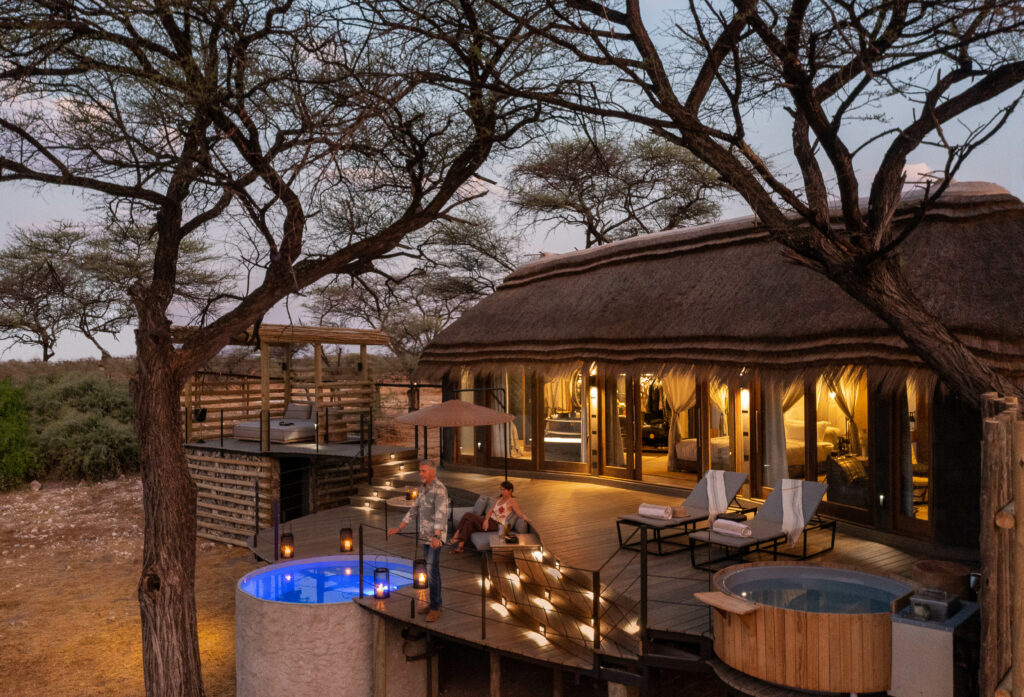
But however much we loved this indulgence (and we really did…), what really blew us both away was the wildlife experience. After all, the reason why Namibia continues to be one of Africa’s most popular safari destinations is the combination of infinitely varied landscapes, iconic wildlife, and unique experiences. During our almost 30 years living in Africa, we have met many guides and been privileged enough to enjoy countless game drives. Camp Kala’s guides are young, and by their own admission still have a lot to learn, but our guide Heno had an infectious curiosity and passion for the local environment which made our experience among the best of any we have enjoyed.
David & I love the meandering storytelling of a game drive and it drives us crazy when guides read from a weary script without any interest; please, for the love of Africa don’t tell us the gestation period of a Springbok (for the fiftieth time), don’t explain in detail which female antelope have horns and which don’t (I couldn’t care less), and don’t drive offroad at speed in search of a shy predator just to try and increase your tip. In stark and welcome contrast our Kala guide Heno told us fascinating stories of how giraffe take note of the wind direction when they browse, to avoid the bitter tannins released by trees and sent on the wind to ‘warn’ neighbouring stationary food sources to start producing their own. He told us how Pale Chanting Goshawks (or PCG’s in local guiding parlance) follow honey badgers around to eat insects and lizards that are grubbed up when the badger is foraging for food. Heno said he watches for goshawks sitting lower down than they usually would, or in groups rather than alone, and then he can be fairly certain that a honey badger is close by…
We had decided to take a morning drive inside the 34,000 ha Onguma Nature Reserve rather than entering Etosha National Park. The reserve borders Etosha, and the fencing is ‘permeable’ meaning that most species are able to come and go easily between the two protected areas. We had heard that wildlife within the reserve had grown substantially in variety and number over the past few years and we were keen to test this out. Despite opting for a later start so we could enjoy a small lie-in, we were certainly not disappointed.
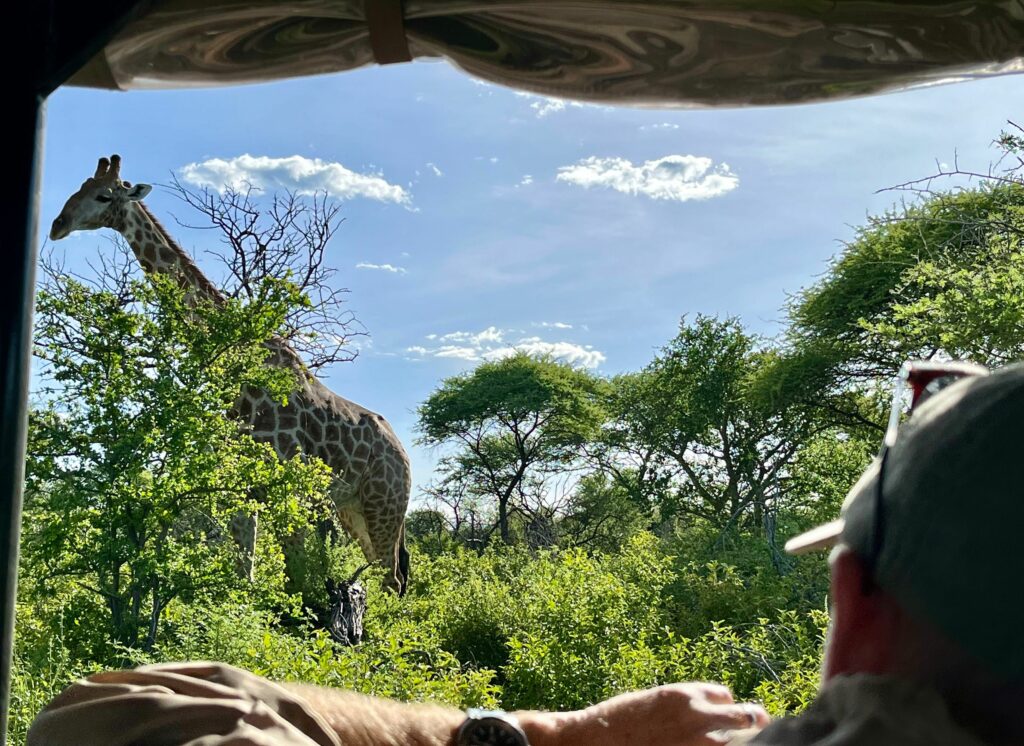
Kala has the major advantage of having exclusive rights to morning drives within the Onguma Reserve. All the other Onguma properties only offer afternoon reserve drives, venturing into Etosha during the mornings. Heno soon heard from the one other vehicle out that morning, and drove us to the edge of the reserve where we could see a lioness lazing underneath a squat acacia tree. She was quite far from us (a good reason to bring along the binoculars provided in every Kala suite), but we enjoyed watching her survey the open landscape whilst relishing the shade. After a short while Heno pointed to the lioness’ right, where a lone wildebeest was trotting towards her. “This should be interesting’’ he grinned as we trained our binoculars on the oblivious wildebeest. Amazingly the hapless animal carried on without a care in the world, walking within a couple of metres of the lioness who was obviously not hungry or energetic enough to try her luck. We later decided that a good collective noun for wildebeest would be ‘a confusion’.
As we drove on from the lioness sighting, Heno received a radio call informing him that one of the staff vehicles had driven past four cheetah cubs a short distance away. Guides don’t generally reveal which species they’ve spotted over the open radio channel, in case guests are disappointed when their guide arrives at the spot only to find that the animal has disappeared. When we worked in Botswana the guides would generally use the Setswana name for the animals, and Heno told us that at Onguma they numbered them but would also sometimes use the local Oshiwambo names. So, it could be worthwhile learning the local names for lion, leopard, cheetah, rhino & elephant before your trip to Namibia!
Luckily for us the cheetah were still lolling atop a termite mound at the side of the road by the time we reached them. Heno said they were around 6-months old and were waiting for their mother who had gone off to hunt. He explained the bird-like call that mother and cubs would use to communicate while they were apart, and we heard them demonstrate this a short time later when one of the cubs became impatient and called for their mother. When she replied with a chirrup of her own, the cubs quickly disappeared into the bush to find out whether her hunt had been successful. We drove around the corner and soon found all five cats reunited, Mum panting heavily but sadly without a kill to share with her cubs. Cheetah cubs stay with their mothers for around 18-months, learning to hunt and kill for themselves. Sibling groups often stay together for another year or so after their mother leaves as their hunting skills are not yet finely honed. Brotherhoods (or even non-related males) can continue to live in collaboration while females become solitary once they start breeding at around 2.5 to 3 years old. Seeing how healthy these cubs were with their shining eyes and glossy coats left us in awe of their mother; it’s difficult enough feeding two hungry adolescents when we humans have access to a fully stocked fridge, let alone hunting elusive prey with sharp, pointy horns on a daily basis. Mum of the year award goes to…
After returning to Kala for a deliciously extravagant lunch overlooking the waterhole, David retired to our suite for an air-conditioned siesta while I made sure I took my familiarisation duties seriously by trying out the Spa. The tranquil double treatment room is set slightly away from the suites, overlooking the bush, and the lovely therapists offer a range of massages using African inspired aromatic oils. We weren’t ready to leave our haven again that afternoon so decided to forego another game drive in favour of hopping between our hot tub and plunge pool whilst emptying the impressively stocked mini-bar and training our binoculars on the waterhole.
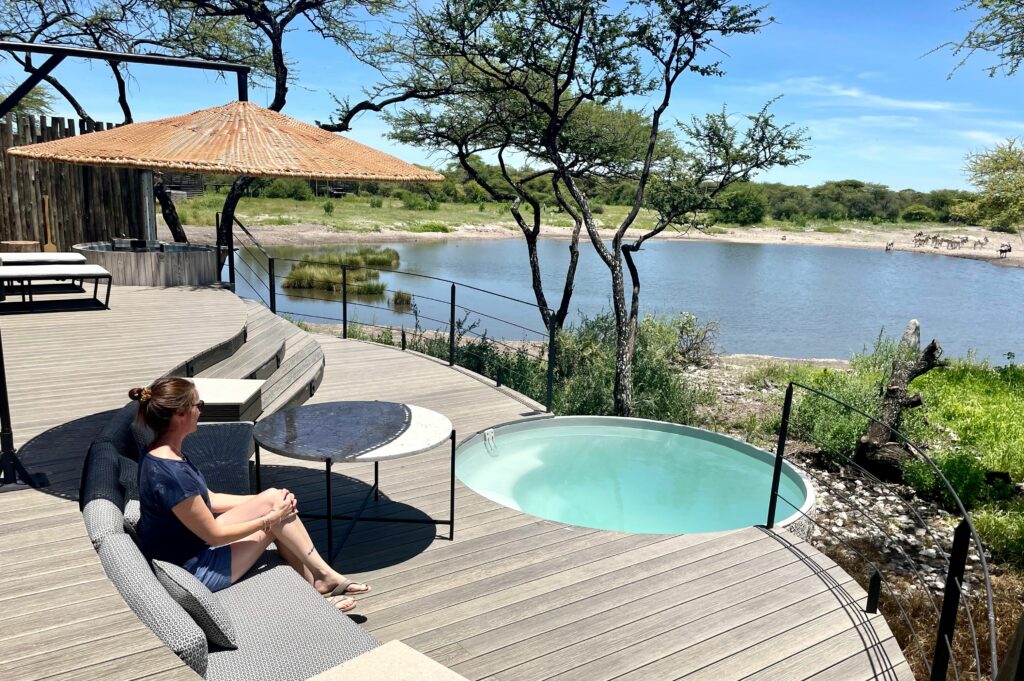
In our experience it’s unusual for a lodge waterhole to offer quite as much action as Kala’s. During the afternoon we saw a group of kudu tiptoe past the side of our suite and down to the water, large herds of zebra coming and going with the youngsters prancing through the dust showing off to each other, and our newly named confusion of wildebeest with their babies in tow like gangly teenagers with too-big ears and punkie hair. There were also groups of Springbok and Impala, and Warthog parents leading their little piggies not to market (thankfully) but to drink in the muddy shallows.
We sat quietly on our deck; reading, wallowing in the hot tub, smelling the dust being gently kicked up by hundreds of hooves, until it was time to think about eating once again. As was to be expected, the food at Kala was a sensation, and included the best vegetarian meal I’ve ever eaten in a Namibia lodge. The wine list was similarly amazing, and we enjoyed a fantastic nights’ sleep under the ‘evening breeze’ air conditioning, which directs gentle wind from a unit behind the bed up and under a canopy, so keeping the cool air around the bed and reducing energy use.
Leaving Kala the following morning took a while; each time we tried to stand up from the breakfast table some waterhole action would catch our eye and we would raise our binoculars again. Finally, knowing we had a long drive to get back to Windhoek, we bid farewell to the twenty or so giraffe who had been gradually journeying to centre stage during our meal, filled our travel mugs with another delicious caffeine fix, and waved goodbye to our Kala family.
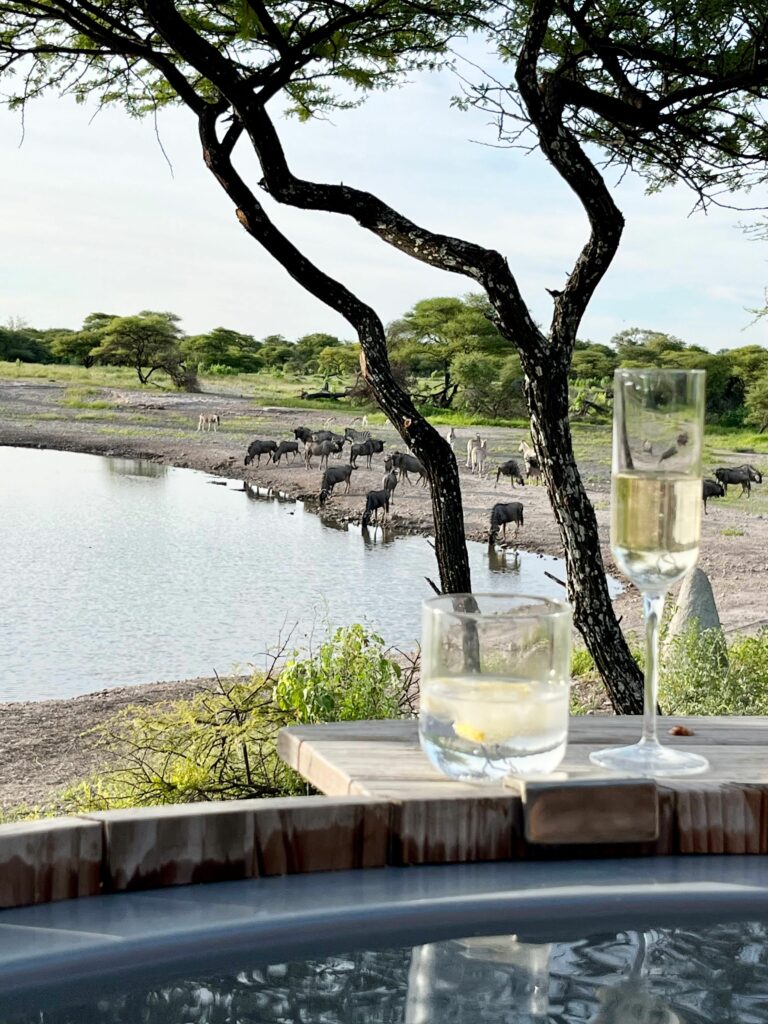
The Onguma Nature Reserve is part of the Namibian black rhino custodianship programme whereby government owns these critically endangered animals, but private reserves are enlisted to take care of them. This involves a responsibility to monitor and protect the individuals, and Onguma has a well-trained, fully equipped Anti-Poaching Unit (APU) patrolling the reserve day and night. Namibia is home to around one third of the World’s total black rhino population which is currently estimated to be around 6,195 according to Save The Rhino. Onguma also established Oshivelo Farming in 2012 to support the local community with a sustainable income, and around 80% of the farm’s workforce are women.
By travelling to these amazing regions and staying in responsible tourism establishments such as the Onguma lodges, guests are actively supporting the future of Namibia’s local communities and their incredible wildlife. Contact us at info@ati-holidays.com